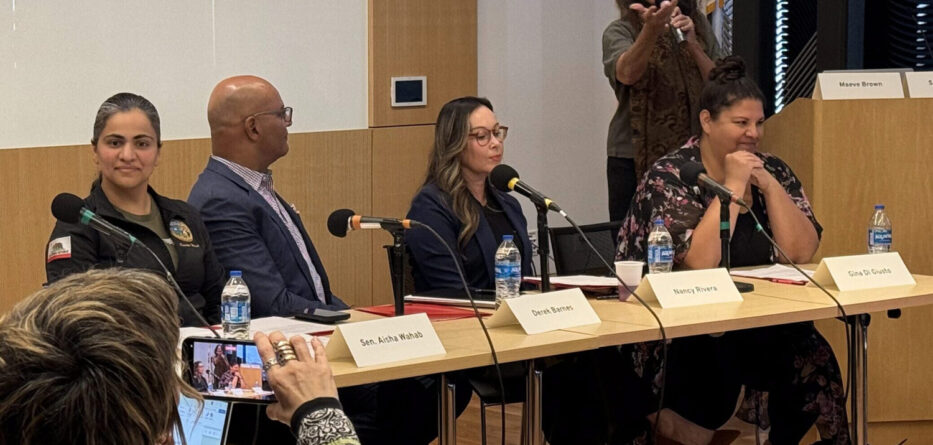Selen Ozturk
American Community Media
HAYWARD, CA — Once a refuge for the American dream of homeownership, Hayward has become a testing ground for California’s housing crisis.
This battle for families to keep their homes in Hayward is a microcosm of struggles to stay housed in diverse, once-affordable areas across the state and country, experts and residents said at a Tuesday, October 14 media briefing held at the downtown library by American Community Media (ACoM) and Housing and Economic Rights Advocates (HERA).
A statewide landscape of crisis
“During the Great Recession, my family lost their home in a foreclosure, and so this issue of the housing crisis is personal for me,“ said Senator Aisha Wahab, a keynote speaker at the event attended by 15 media and 15 housing experts and community advocates.
“Nearly 15 years later, I’m still a renter, and that’s the story of millions of Americans,” continued Wahab, who represents California’s 10th district, including Hayward, and who is the only renter in the 40-member state Senate.
With a $100,000 yearly salary considered “low-income” by the state in five Bay Area counties, even the affordability floor is too high for families living one paycheck or illness away from losing everything.
In California, foreclosure rates have risen 20% from 2024 to 2025, while foreclosure starts — meaning the first required notice of default — have risen 44%.
“This pattern looks very much to me like what we saw in the lead-up to the great 2008 foreclosure crisis,” said Maeve Brown, executive director of HERA — but with more debt. In 2008, U.S. mortgage debt was $9 trillion. This year, it reached $13 trillion.
Nor is this crisis limited to homeowners.
“Tenants’ ability to survive is woven into homeowners’ abilities to survive,” Brown explained. “You think about 2008 or the pandemic and how many grown-up kids flocked back to the family home, for those lucky enough to hold onto one … That home is a source of security for the people who own it and for the next generation.”
“Having conversations with people who have not rented in the last 20 years, they’re unaware of how renters are treated. They’re unaware of the fee after fee after fee,” added Wahab, who was elected in 2022 after four years on the Hayward City Council.
Since then, she has passed legislation securing $300 million for down-payment assistance, securing $500 million for homelessness prevention, raising the renter’s tax credit for the first time in decades, capping HOA fines at $100, allocating $1.4 billion for affordable housing in this year’s state budget amid a deficit and advancing the nation’s first social housing bill to create 1.4 million affordable units statewide.
But supply and demand won’t fix a crisis when the supply is unaffordable, she cautioned: “In 2023 we developed a little over 100,000 units in the entire state. We’re 2.5 million units in need for our actual population, and 1 million of those units needs to be for affordable housing … but here in Alameda County, the average cost of a home is $1.4 million.”
The crisis in Hayward
“When we compare this city to the county, we see a lower-income community,” said Hayward Housing Manager Christina Morales.
Roughly 47% of Hayward’s homeowners earn less than the median local income, while 70% of Hayward’s tenants earn less.
“There’s no benefit even to affordable housing for renters” when affordable housing in the city is pegged up to 80% Area Median Income (AMI) “yet 46% of tenants are cost-burdened,” explained Morales. “It’s very challenging to save money to become a homeowner at all. They’re just trying to make rent.”
“One thing about Hayward is that having a single income makes it nearly impossible to purchase a home on your own,” added Mizgon Zahir, a second-generation homeowner whose parents fled to Hayward as Afghan refugees.
Zahir, who once rented in the city as a single mother, continued: “When I met my current partner, we merged families, and bought my second home. But his adult children live with us and contribute to the household, and we’re still constantly under pressure: If my health fails, or one of us loses work, what will happen to our family? The generations that come after us will continue to face this.”
Although Hayward itself exceeded its housing goals by roughly 107% in its last planning cycle between 2014 and 2022, “the gap remains for units that are below-market,” said Derek Barnes, CEO of the East Bay Rental Housing Association. (EBRHA).
For EBRHA homeowners as for those in Hayward, small property owners are the backbone of affordable rentals — but many of these owners are older adults in danger of losing their own housing.
About 55% of EBRHA members own four or fewer units, and most members are older than 60 — but 54% of these owners over 60 are currently in danger of losing their house.
“We need to look at the specific needs of those smaller owners,” said Barnes. “It’s not enough to describe them based on the units that they hold. It’s their access to capital for major or minor repairs that threatens habitability … and that threatens keeping the home at all.”
As of 2022, nearly 80% of U.S. senior adults owned their homes, but over one-third were cost-burdened, paying over 30% of their income on housing.
“The home is aging along with our bodies,” said Brown. “The home needs care and you need to be able to pay for repairs. Where does that money come from when you’re barely holding on?”
Morales added that one affordable senior housing complex recently built in Hayward, providing AMI rents between 30% and 60%, denied 41% of applications “because the seniors’ income was too low … Even renting is no longer an opportunity.”
The struggle to stay housed
At the community level, Hayward’s families are now joining forces to survive.
Nancy Rivera, executive director of Hayward-based counseling organization A-1 Community Housing, said “For many of our clients, the dream of owning a home now means pooling resources across multiple households just to qualify for a $6,000 mortgage or a $700 HOA … It’s a testament to a market that’s increasingly out of touch with working families.”
“Many years back, many of my family and friends couldn’t afford to live in San Francisco, and they made the decision to move to Hayward. Once, Hayward was that affordable place,” she continued. “Now, we are seeing a lot of families moving to Modesto, to Stockton, they’re moving out of state.”
Now, as during the 2008 crisis, the first lesson A-1 teaches their clients is whether home ownership is right for them at all.
“Home ownership is not for everyone … many people believe that, having a high credit score, they can buy a property, but how much stable income do they have?” explained Rivera. “We’re seeing new young adults who come to our office, who witnessed that through their parents, and they don’t want to get into home ownership.”
Kary Hua, housing program manager and counselor at ASIAN, Inc., agreed: “Even 10 years ago, people here could rent and count on later on buying, but now renters can barely keep afloat on the first step,” she explained, adding that while forbearance and foreclosure relief programs are still available as they were during the recession and the pandemic, “our families find there’s so much less federal funding now.”
“The story of home ownership is the story of abilities,” said HERA Senior Attorney Gina Di Giusto. “Is there availability? Affordability? Eligibility? Sustainability? Can you actually keep the home that you fought so hard to finally get?”
Far from being the finish line, she continued, homeownership is when troubles escalate with servicers miscalculating fees, HOAs forcing thousands of dollars in assessments and repair, scammers promising foreclosure rescue and heirs losing family homes because there’s no trust or will.
“If you’re a homeowner, if you want to be one, you need legal help,” added Brown. “For longtime owners, your family home is still the cheapest housing you’ll ever have. Let us help you keep it.”





